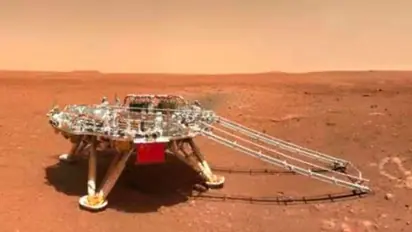New tech promises trip to Mars in just 45 days

Synopsis
A newly published scientific paper outlines how a giant laser array could be used to propel a spacecraft to Mars in just 45 days.
This piece of news sounds like the stuff of science fiction, but some researchers think it could be the future of space travel. Scientists from the Delft University of Technology (TU Delft) in the Netherlands have introduced the idea of using a laser-thermal propulsion system to reduce the time taken to reach Mars.
NASA predicts it would take about 500 days for humans to reach the Red Planet, but Canadian engineers say a laser-based system could cut that journey to just 45 days.
For starters, missions can only launch for Mars every 26 months when our two planets are at the closest points in their orbit to each other (during an ‘Opposition’). Using current technology, it would take six to nine months to transit from Earth to Mars.
Also read: ISRO successfully launches PSLV-C52 with Earth Observation Satellite, 2 others
In an interview with Universe Today, the lead researcher Emmanuel Duplay from TU Delft said that the NASA-funded Starlight program, also known as the Directed Energy Propulsion for Interstellar Exploration (DEEP-IN), inspired him for the study. The DEEP-IN program also uses laser technology to propel a spacecraft into deep space. “We were interested in how the same laser technology could be used for rapid transit in the Solar System, which will hopefully be a nearer-term steppingstone that can demonstrate the technology,” Duplay told Universe Today.
The paper describes using a 10-meter-wide laser array — many little lasers put together to create a giant laser – with the power of 100 megawatts to send a craft that weighs roughly as much as a Mars rover to the red planet. To give an idea of how powerful the laser is, it projects thousands of times the power of sunlight. It’s a laser array so powerful, it’s essentially unheard of.
The spacecraft accelerates very quickly while near Earth, then races towards Mars over the next month, releasing the main vehicle to land on the Red Planet and returning the rest of the vehicle to Earth to be recycled for the next launch.
The US space agency is planning to send a crew to the Red Planet in the middle of the 2030s, around the same time China also plans to land humans on Mars.
Reaching Mars in just six weeks is something previously only thought possible using nuclear fission powered rockets, which present increased radiation risks.
Also read: Chandrayaan 3 mission scheduled for launch in August 2022
Also read: NASA offers $1 million for innovative ideas to feed astronauts in 'Deep Space Food Challenge'